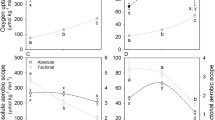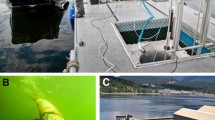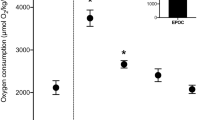Abstract
Maximum submergence time of Canada geese was 18% of that of similarly sized Pekin ducks. Due to a smaller respiratory system volume the oxygen store of Canada geese was 82% of that of Pekin ducks, accounting for approximately 33% of the difference in underwater survival times. The respiratory properties and volume of the blood were similar in both species. Both species utilised approximately 79% of the respiratory oxygen store and 90% of the blood oxygen store. Therefore, most of the species difference in survival times was due to a less effective oxygen-conserving cardiovascular response (bradycardia, peripheral vasoconstriction) in Canada geese. Duck cardiac chronotropic sensitivity to hypoxia during submergence was twice that observed in geese. Furthermore, a lower hypoxic ventilatory response was observed in geese than in ducks. Density of monoamine varicosities in hindlimb artery walls was lower in geese than ducks. However, electrical stimulation of the hindlimb muscles did not cause ascending vasodilation during submergence in either species, perhaps due to higher levels of catecholamines in submerged geese. We conclude that the major difference between species is higher oxygen chemosensitivity in ducks which effects a much more rapid and efficacious oxygen-conserving response during forced submergence.
Similar content being viewed by others
Abbreviations
- ATPS · BTPS · STPD:
-
CNS central nervous system
- EEG :
-
electroencephalogram
- ECG :
-
electrocardiogram
- EDTA :
-
ethylenediaminetetra-acetic acid
- HPLC :
-
high performance liquid chromatography
- \(F_{{\text{IO}}_{\text{2}} }\) :
-
fractional oxygen concentration of inspired air
- \(F_{{\text{rsO}}_{{\text{2rest}}} }\) :
-
pre-immersion fractional concentration of oxygen in the respiratory system
- \(F_{{\text{rsO}}_{{\text{2sub}}} }\) :
-
pre-emersion fractional concentration of oxygen in the respiratory system
- [Hb]:
-
haemoglobin concentration
- Hct :
-
haematocrit
- HR :
-
heart rate
- M B :
-
body mass
- M b :
-
brain mass
- M h :
-
heart mass
- \(P_{{\text{aCO}}_{\text{2}} }\) :
-
partial pressure of carbon dioxide in arterial blood
- \(P_{{\text{aO}}_{\text{2}} }\) :
-
partial pressure of oxygen in arterial blood
- SPG :
-
sucrose-potassium phosphate-glyoxylic acid
- t d :
-
maximum underwater survival time
- \(\dot V_{\text{E}}\) :
-
respiratory minute volume
- V pl :
-
plasma volume
- V rs :
-
respiratory system volume
- \(V'_{{\text{rsO}}_{\text{2}} }\) :
-
accessible respiratory system oxygen store
- \(V_{{\text{taO}}_{\text{2}} }\) :
-
total non-myoglobin-bound oxygen store
- V tb :
-
blood volume
- \(V_{{\text{tbO}}_{\text{2}} }\) :
-
blood oxygen store
References
Black CP, Tenney SM (1980) Oxygen transport during progressive hypoxia in high-altitude and sea-level waterfowl. Respir Physiol 39:217–239
Black CP, Tenney SM, Kroonenberg M van (1978) Oxygen transport during progressive hypoxia in bar-headed geese (Anserindicus) acclimatized to sea level and 5600 meters. In: Piiper J (ed) Respiratory function in birds, adult and embyonic. Springer, Berlin Heidelberg New York, pp 79–83
Bouverot P, Douguet D, Sebert P (1979) Role of the arterial chemoreceptors in ventilatory and circulatory adjustments to hypoxia in awake Pekin ducks. J Comp Physiol 133:177–186
Bryan RM Jr, Jones DR (1980) Cerebral energy metabolism in diving and non-diving birds during hypoxia and apnoeic asphyxia. J Physiol (London) 299:323–336
Butler PJ (1970) The effect of progressive hypoxia on the respiratory and cardiovascular systems of the pigeon and duck. J Physiol (London) 201:527–538
Christensen EH, Dill DB (1935) Oxygen dissociation curves of bird blood. J Biol Chem 109:443–448
Cohn JE, Krog J, Shannon R (1968) Cardiopulmonary responses to head immersion in domestic geese. J Appl Physiol 25:36–41
Colacino JM, Hector DH, Schmidt-Nielsen K (1977) Respiratory responses of ducks to simulated altitude. Respir Physiol 29: 265–281
De La Torre JC (1980) An improved approach to histofluorescence using the SPG method for tissue monoamines. J Neurosci Methods 3:1–5
Faraci FM, Kilgore DL Jr, Fedde MR (1984) Oxygen delivery to the heart and brain during hypoxia: Pekin duck vs. bar-headed goose. Am J Physiol 247:R69-R75
Florin-Christensen J, Florin-Christensen M, Corley EG, Garcia Samartino L, Affanni JM (1986) A novel receptive area of key importance for the onset of diving responses in the duck. Arch Int Physiol Biochim 94:29–35
Folkow B, Fuxe K, Sonnenschein RR (1966) Responses of skeletal musculature and its vasculature during “diving” in the duck: peculiarities of the adrenergic vasoconstrictor innervation. Acta Physiol Scand 67:327–342
Garland T Jr, Adolph SC (1994) Why not to do two-species comparative studies: limitations on inferring adaptation. Physiol Zool 67:797–828
Hanwell A, Linzell JL, Peaker M (1971) Cardiovascular responses to salt-loading in conscious domestic geese. J Physiol (London) 213: 389–398
Hudson DM, Jones DR (1982) Remarkable blood catecholamine levels in forced dived ducks. J exp Zool 224:451–456
Hudson DM, Jones DR (1986) The influence of body mass on the endurance to restrained submergence in the Pekin duck. J Exp Biol 120:351–367
Hunsaker WG (1968) Blood volume of geese treated with androgen and estrogen. Poult Sci 47:371–376
Huxley JS (1912) A “disharmony” in the reproductive habits of the wild duck (Anas boschas, L.). Biologisches Zentralblatt 32:621–623
Irving L (1934) On the ability of warm-blooded animals to survive without breathing. Sci Mon 38422–428
Jones DR, Holeton GF (1972) Cardiovascular and respiratory responses of ducks to progressive hypocapnic hypoxia. J Exp Biol 56:657–666
Jones DR, Purves MJ (1970a) The carotid body in the duck and the consequences of its denervation upon the cardiac responses to immersion. J Physiol (London) 211:279–294
Jones DR, Purves MJ (1970b) The effect of carotid body denervation upon the respiratory response to hypoxia and hypercapnia in the duck. J Physiol (London) 211:295–309
Lacombe AMA, Jones DR (1991a) Role of adrenal catecholamines during forced submergence in ducks. Am J Physiol 261:R1364-R1151
Lacombe AMA, Jones DR (1991b) Neural and humoral effects on hindlimb vascular resistance of ducks during forced submergence. Am J Physiol 261:R1579–1586
McKinney F, Derrickson SR, Mineau P (1983) Forced copulation in waterfowl. Behaviour 86:250–294
Petschow D, Wurdinger I, Baumann R, Duhm J, Braunitzer G, Bauer C (1977) Causes of high blood O2 affinity of animals living at high altitude. J Appl Physiol 42:139–143
Ronald K, George JC (1988) Seasonal variation in certain hematological and respiratory properties of the blood of four races of Canada geese, Branta canadensis. Zool Anz 220:71–78
Scheipers G, Kawashiro T, Scheid P (1975) Oxygen and carbon dioxide dissociation of duck blood. Respir Physiol 24:1–13
Tong J, Baines AD (1993) In patients receiving dopamine infusions for treatment of shock do free radicals convert dopamine to 6-hydroxydopamine? Clin Biochem 26:199–205
Van Nice P, Black CP, Tenney SM (1980) A comparative study of ventilatory responses to hypoxia with reference to hemoglobin O2-affinity in llama, cat, rat, duck and goose. Comp Biochem Physiol 66A:347–350
Viscor G, Fuentes J, Palomeque J (1984) Blood rheology in the pigeon (Columba livia), hen (Gallus gallus domesticus), and black-headed gull (Larus ridibundus). Can J Zool 62:2150–2156
West NH (1981) The effect of age and the influence of the relative size of the heart, brain, and blood oxygen store on the responses to submersion in mallard ducklings. Can J Zool 59:986–993
Williams JI, Trainer DO (1971) A hematological study of snow, blue, and Canada geese. J Wildl Dis 7:258–265
Author information
Authors and Affiliations
Additional information
Communicated by L.C.-H. Wang
Rights and permissions
About this article
Cite this article
Stephenson, R., Evans, B.K. & Jones, D.R. Physiological mechanisms for underwater endurance: Canada goose (Branta canadensis) versus Pekin duck (Anas platyrhynchos). J Comp Physiol B 166, 46–54 (1996). https://doi.org/10.1007/BF00264638
Accepted:
Issue Date:
DOI: https://doi.org/10.1007/BF00264638




